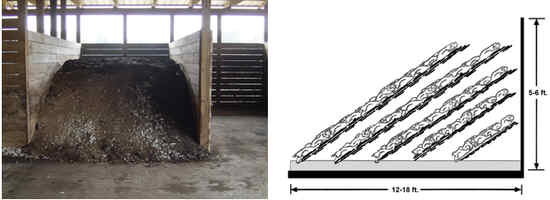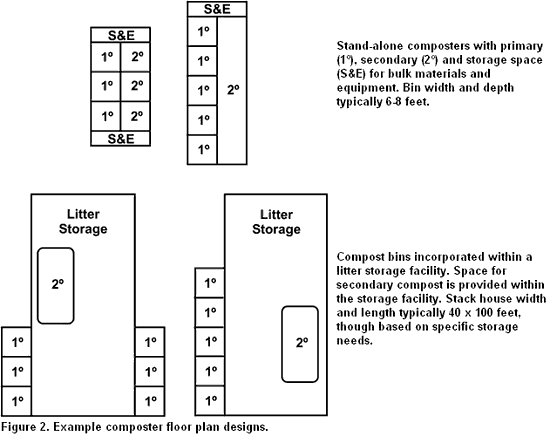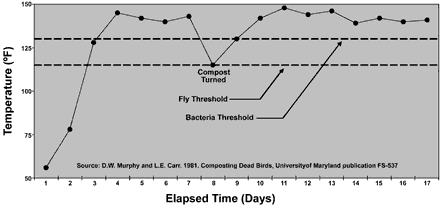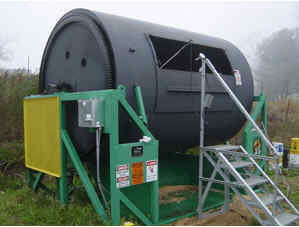



Poultry Mortality Composting Management Guide
By Casey W. Ritz, Extension Poultry Scientist and John W. Worley, Extension Engineer, University of Georgia - Disposal of dead birds can be a problem for poultry growers. Typical methods of mortality disposal include burial, incineration, rendering, and composting. Many states have banned the use of burial pits that historically have been used to dispose of dead birds. Incineration can be costly and raise air quality concerns, and the decreasing number of renderers further complicates disposal.Composting is considered a positive alternative method of processing dead birds in an environmentally sound manner. Composting is the most widespread method used in states that have banned pits, and is considered by many as the best alternative for mortality management, though more labor intensive than other methods. The composting process converts dead birds into a useful, inoffensive, stable end product that can be field-applied for crop use and soil improvement. This relatively inexpensive method of using dead birds has gained wide acceptance throughout the poultry industry. Availability of cost-share funds to offset composter facility construction costs has contributed to the increase in the use of this mortality disposal method.
Principles of Composting
Composting is a natural, biological process by which organic material is broken down and decomposed into a stable end product. The composting process is carried out by bacteria, fungi and other microorganisms which digest the organic material and reduce it to humus. The principles of composting are quite simple — provide the microorganisms with an environment conducive to their growth — a balanced diet, water and oxygen.
The essential elements for the microorganisms involved in composting are carbon (C), nitrogen (N), oxygen (O2) and moisture (H2O). If any of these elements are lacking, or if they are not provided in the proper proportion to one another, the microorganisms will not flourish and generate adequate heat for decomposition. These nutrients are best supplied from an ingredient profile that has a carbon to nitrogen ratio of approximately 30:1. Birds have a C:N ratio of 5:1, litter ranges from 7:1 to 25:1, straw 80:1, peanut hulls 50:1, and wood shavings are 300-700:1. A good carbon source will perform two functions: provide carbon and act as a bulking agent that creates pores within the pile, allowing oxygen to flow through the material. If 2 parts by volume of litter and 1 volume of dead birds along with adequate bulking agent is contained in the litter or added prior to the carcasses, the C:N ratio should be adequate for the composting process to proceed.
The microorganisms best at composting are aerobic; that is, they require oxygen to live. During the composting process oxygen is used up quickly by microorganisms inside the compost pile. Aerating the compost by turning re-supplies it with oxygen and allows the microorganisms to continue the composting process at a rapid rate.
Water is essential to the growth of all living organisms. Composting microorganisms thrive best in moist conditions. Desirable moisture levels in the composting materials should be 40 to 60 percent. Too much water can cause the compost pile to become soggy and anaerobic; too little water will prevent microorganisms from reproducing to adequately high numbers. The amount of water needed depends on the size of birds being composted and the moisture content of the litter and/or carbon bulking material. As a rule of thumb regarding proper moisture content, well-watered compost when squeezed into a ball will not drip water and will retain its shape when released.
Composter Construction and Layout
When siting a composter, choose a well-drained, graded and elevated location so ground water and surface runoff cannot enter the facility. The composter must also be located and graded such that it is accessible year round.
The size of a composter is typically based on the size of the poultry operation. For every 1 pound of dead bird, 1 cubic foot of primary compost space is needed. An equal amount of space is required for the secondary stage. The National Resource Conservation Service (NRCS) has standard designs and cost-share programs for composters of various sizes. Growers interested in composting and cost-share opportunities should contact their local NRCS office for funding information and design approval.
A typical poultry mortality composter consists of various sized bins constructed of treated lumber set on a concrete slab with a roof overhead. The roof helps maintain appropriate moisture levels within the compost. The concrete slab helps prevent leaching of nutrients into the soil, prevents vermin and pests from burrowing under the compost, and makes cleanup of the facility easier.
Typically the bins are constructed large enough to accommodate the equipment used to handle the material. Therefore, the width of the small bin composter must allow the loader bucket to get into the bin. Normally these small bin composters will be 6-8 feet wide by 5 feet high and 5 feet deep. The depth of the bin may be limited to the reach capabilities of the front end loader in order to drop the composted material into the secondary bin, which may be located behind the primary bin. Moving the material from the primary bin to the secondary bin after 10 to 21 days is common for small bin type composters to mix in oxygen in the mass to promote additional heating. The oxygen is added to the mixture as it is moved from the primary bin to the secondary bin.

Figure 1: Bin composting on an angle can reduce time spent handling materials.
A modification to the small bin composter that is gaining in popularity is the use of a primary bin that is 5-10 feet deeper and with a front that is totally open. The compost material slopes back from the front of the composter at about a 45 degree angle (Figure 1). This design allows improved ingredient layering using a front end loader, so it requires less hand work. This modification can accommodate larger scale operations and material volumes. The primary and secondary bins are usually side by side or parallel to each other and built like a bunker silo. The big bin composter like the small bin type is filled to a height of 5 to 6 feet. Electrical power and a reliable water source are important necessities that should be made available at the composter to facilitate optimal year round composting. Example floor plans for stand alone composters and those integrated into a litter storage facility are shown in Figure 2.

Composter Operation and Management
The requirements for proper and complete decomposition of dead carcasses are reasonably simple and inexpensive. The materials needed (dead birds, litter, alternative carbon sources, water) are readily available on every poultry farm. Careful attention to proper management is essential for successful composting. Failure to manage the system will result in an odorous situation that attracts flies, scavengers and other vermin to the site. Proper management is vital for avoiding nuisance complaints.
Decomposition of the dead carcasses and litter depends upon microbial activity. The greater the microbial growth, the faster the carcasses decompose. Anything that slows down microbial growth lowers the temperature of the composting material and slows the composting process. The more rapid the microbial growth, the greater the heat output within the composting mass and the more rapidly the mass breaks down. The microorganisms responsible for composting are initially supplied by active or fresh litter material. The microbes in the litter used in the composting process need to be kept alive and in sufficient numbers so the composting process can begin immediately to break down the carcasses and the litter. Litter that is too dry and too long removed from the house will contain lower numbers of microorganisms and its use slows the process of carcass decomposition. Keeping a small amount of active compost on hand to seed new compost bins is an excellent compost management strategy and efficient way to use finished compost.
Oxygen is initially supplied when the carcasses and litter are placed within the composter. If all the necessary requirements for composting are in the correct proportion, composting will begin immediately with a corresponding rise in temperature of between 130 and 150 degrees F within a few days (Figure 3). Temperatures that exceed 150 degrees F will eliminate pathogenic microorganisms and insect pests present within the compost. As oxygen becomes limited, the composting process and the temperature of the mass will decrease. The composting process can be sustained at higher temperatures by using a bulking agent which creates air pockets in the compost pile and thus supplies more oxygen to the composting process. A coarse material, such as wood shavings, straw or peanut hulls will ensure more oxygen, allowing higher composting temperatures for an extended time before it begins to drop. Adding more litter or litter cake increases heating. If litter cake is used, little or no bulking agents are needed. Finished compost can be used as the bulking material in place of new carbon-containing material up to 50 percent of the mix.
If the litter is too fine, oxygen will be limited to the microorganisms, slowing their growth. Slower microbial growth causes a lower composting temperature with slower digestion of the birds. If the temperature of the compost does not reach at least 130 degrees F, birds nearer the walls where it is cooler will decompose very slowly. Proper management and operation of the composter is relatively easy when the basic principles are followed. The amount of labor required to compost birds is reasonably low.

Figure 3: Typical temperature profile of a two-stage composter.
Note the pest and microbial threshold limits.
Two-Stage System
In two-stage composting, the first stage generates heat and major tissue breakdown. The second stage after turning continues the process and homogenizes the material. Orderly loading of ingredients is necessary for efficient compost activity. Layer ingredients into the composter as illustrated in Figure 4.

Figure 4: Mortality composter profile.
Place an initial layer of 8 to 12 inches of fresh litter on the floor. This litter will supply bacteria to start the process and will also help absorb carcass fluids or excess water that may be added to the composter.
Next add a thin layer of bulking material such as peanut hulls, coarse shavings or straw. Litter cake, if used in the composter, can replace the need for adding this layer of bulking material.
Now add a layer of bird carcasses. Arrange the carcasses in a single layer side by side, touching each other. Place carcasses no closer than 6 inches from the walls of the composter. Carcasses placed too near the walls will not compost as rapidly due to lower temperatures there and may cause in odorous liquids to seep from the compost pile.
A small amount of water may be needed after each carcass layer. Typically, thoroughly wetting the carcasses will add sufficient water to the mix to achieve the needed moisture level. If much water is needed, the litter is likely too dry and low in live bacteria. Using finished compost material or fresh litter directly out of the chicken house can prevent this situation.
Next, add a layer of litter. This layer should be twice as thick (8-10 inches) as the layer of carcasses underneath. If only a partial layer is needed for a day’s mortality, the portion used must still be covered with litter. The rest of that layer can be used with subsequent mortality.
After completing the initial layer, add subsequent layers of carcasses, bulky ingredient and litter until a height not exceeding 5 to 6 feet is reached. The last layer will be a cap of 8-10 inches of litter. Compost piles limited to 5 to 6 ft in depth, with adequate porosity and moisture levels, do not pose a fire hazard. Keep in mind, however, the potential for spontaneous combustion as temperatures are monitored throughout the composting process. Excessive height can induce higher compost temperatures that exceed 170 degrees F and increase the chance of spontaneous combustion.
Larger birds may require extra care during composting. Additional water or carbon material may need to be added to better facilitate the decomposition process and additional heating cycles may be needed to produce an acceptable end product.
Bin composters are designed to accommodate normal mortality. And while they may successfully handle above-average losses, they are not designed for catastrophic losses that can be caused by excessive heat, building collapse, highly pathogenic diseases, etc. Catastrophic losses can be successfully composted within carefully constructed and managed windrows. Information on composting catastrophic mortality can be obtained from the Cooperative Extension Service.
Problems with operation of the composter can be solved by reapplying the concepts of good compost management. (See Troubleshooting Guide.)
Temperature
Temperature in the range of 130 to 150 degrees F inside the compost pile is evidence that a composter is working well and that the composter environment is suitable. These high temperatures are produced by the biological activity of the microorganisms that are breaking down the organic material in the pile. High temperatures enhance the growth and reproduction of thermophilic (heat-loving) bacteria that are especially good at digesting organic material.
The heat produced by the microorganisms not only contributes to their own growth, but also speeds up the decomposition process and helps kill pathogenic microorganisms that may be present. For the composter to work properly, temperatures need to be higher than 130 degrees F. When oxygen becomes limited, the temperature of the compost will begin falling. By the time it drops to 130 degrees F (about 7 to 21 days after capping), the compost can be turned. Moving the material aerates the mixture and revives the microorganisms so another heat cycle can occur, leading to a more complete breakdown of the compost. The movement to a second cell will probably be necessary to get adequate decomposition if the birds exceed 4½ to 5 pounds.
The compost temperature should again rise to 150 degrees F within days. Delayed movement, poor aeration, poor mixing, or moisture above 60 percent or below 40 percent will prevent the mass from heating properly.
Once the temperature determined by daily monitoring drops from 150 to 130 degrees F (7 to 21 days), the product can be moved again to await its use as a fertilizer and soil amendment in the same manner as poultry litter. Do not store finished compost with dry litter. The interface between the moist and dry material is an ideal location for spontaneous combustion to occur.
Pests and Pathogens
Fly larvae, pathogenic bacteria and viruses are destroyed through the combined effects of time and temperature during composting. Typical temperatures achieved during composting exceed the human waste treatment requirements of the Environmental Protection Agency (130 degrees F for 15 days). Because biocidal temperatures are not reached at the outer edges of the primary compost bins, turning and mixing the compost at least once is needed to ensure the destruction of pathogens and nuisance insects. Monitoring compost temperatures and maintaining good management practices throughout the entire process helps ensure the elimination of insect larvae and pathogens in the final product.
Rodents, scavenging animals and other pests are seldom a problem with a properly managed composter. The solid construction and concrete floor of the composter will discourage ground level entry. Habitual raiders can be kept from the compost with fencing or some other building material. Trapping of pests may be appropriate where legal.
Compost Use
Well composted mortality can be used as a soil conditioner and nutrient source for crops just as fresh poultry litter. Compost is typically lower in nitrogen and slightly higher in phosphorus and potassium than manure and is thought to release nitrogen at a slower rate and over a longer period of time than fresh manure. The soil-amending and plant food properties of compost make it a valuable byproduct of poultry production. Marketing the compost can provide producers with an additional income stream to their agricultural operations.
Users of compost are encouraged to obtain a nutrient analysis of the product prior to its use. If analysis data is not obtained or is not available at time of use, the following average values may be used as a reasonable estimate of the available nutrient content of dead bird compost:
| Total Nitrogen (N): | 44 lbs/ton |
| Phosphorus (P2O5) | 65 lbs/ton |
| Potassium (K2O) | 48 lbs/ton |
We recommend that mortality compost not be spread on active pastureland or home gardens because of the potential for botulism poisoning in grazing animals or humans. Botulinum bacteria can survive for long periods of time, especially in bones. If bones have been successfully decomposed by the composting process, the threat of botulism is decreased. As a general rule, mortality compost should be spread on hay fields or cropland where grazing animals will have no opportunity to consume the material.
Innovations
Composting has proven to be an effective, environmentally sound method of dead bird disposal. Emerging technologies that enhance the composting process further promote and expand the use of composting as a mortality disposal method. Aerated-bed and in-vessel rotary drum composting units are at the leading edge of composting technology. These systems may decrease the time and daily management needed to compost material through controlled infusion of air and simplified aeration techniques. These new mechanized compost technologies can be initially cost-prohibitive. However, government cost-share programs are being made available that can offset the cost to the producer sufficiently to where the initial purchase cost of the technology is similar to two-stage bin composter construction.

Figure 5: In-vessel rotary composter with forced air infusion capabilities.
[Courtesy Industrial Piping, Inc.]
Enzyme and microbial products marketed as compost accelerants are also relatively new products that may be used to enhance the composting process, especially if the materials being composted do not have sufficient bacteria levels to initiate the process, such as with old litter or yard trimmings. These products require adequate moisture and appropriate ingredient materials in order to function properly, just as with normal composting procedures. Whether or not a product will improve the composting process depends very much on individual circumstances. The need or addition of such a products should be based on composting success or failures at a given location and with the use of the materials that are to be used on a daily basis.
Regulations
Mortality Disposal Permit Policy
All poultry production operations in Georgia are required to have written approval or certificate by the Georgia Department of Agriculture for the disposal of dead poultry. Restrictions and usage guidelines for each disposal method are covered within the regulations by the department. Approved methods and certificates of compliance are issued on a case by case basis as a grower selects the method and site location best suited for his particular operation. The department shall approve the method and location for disposal at each location through an on-site visit by a departmental inspector.
Obtaining a Composting Permit
In order to obtain a permit for composting poultry mortalities, Georgia growers must submit a written request to the State Veterinarian. The letter requesting the permit should state the name that is to appear on the certificate of compliance and describe the disposal method of choice. It must also include any existing pit numbers where applicable. If the farm is new, this should be stated at the time of the request. Requests for a dead bird disposal permit must be mailed to:
Georgia Department of Agriculture
Animal Industry Division
19 M.L. King Jr. Drive, Room 106
Atlanta, GA 30334
Land Application
Georgia does not require that mortality compost remain on the premises of the grower where the mortality originated. Well composted material can be transported and used off-site just as with poultry house litter. Though not defined in the regulation, in order to be “well composted,” the material should have undergone at least two heat cycles and be devoid of flesh.
| Troubleshooting Guide for Carcass Composting | |||
| Problem/Symptom | Probable Cause | Suggestions | |
| Improper temperature | Too dry (less than 40% moisture). | Add water. | |
| Too wet (more than 60% moisture). | Add bulking material and turn pile. | ||
| Improper C:N ratio. | Evaluate bulking material and adjust as necessary. | ||
| Improper mixing of ingredients. | Layer ingredients appropriately. | ||
| Adverse Environment. | Ensure adequate cover. | ||
| Failure to decompose | Improper C:N ratio |
Evaluate bulking material and adjust as necessary. | |
| Carcasses layered too thickly. | Single layer the carcasses. | ||
| Carcasses on outside edges. | Maintain 6-10 inches between carcasses and edges. | ||
| Odor | Too wet. | Add bulking material and turn. | |
| Too low C:N ratio. | Evaluate bulking material and adjust as necessary. | ||
| Inadequate cover over carcasses. | Cover with 10-12 inches of bulking material. | ||
| Flies | Inadequate cover over carcasses. | Cover with 10-12 inches of bulking material. | |
| Poor sanitation conditions. | Avoid leaching from pile. | ||
| Too wet. | Turn pile and add bulking material. | ||
| Failure to reach proper temperature. | Assess C:N ratio, layering. | ||
| Scavenging animals | Inadequate cover over carcasses. | Maintain 10-12 inch cover. Avoid initial entry with fence or barrier. |
|
References and Resources
1996. Managing poultry mortality composting systems. Agdex 537/727. British Columbia Ministry of Agriculture, Food and Fisheries.
2001. Composting poultry mortality. AL 317. NRCS Alabama Guide Sheet.
2003. Rules of Georgia Department of Agriculture Animal Industry Division. Chapter 40-13-5, Dead Animal Disposal.
Adams, D., C. Flegal, and S. Noll. 1994. Composting Poultry Carcasses. NRC-530. Purdue University, Cooperative Extension Service, West Lafayette, Ind.
Blake, J.P. 2003. How well are you composting? Poultry Digest Online, Vol. 3, No. 8.
Brodie, H.L., and L.E. Carr. 1997. Composting animal mortalities on the farm. FS-717. University of Maryland, Cooperative Extension Service, College Park, Md.
Collins, E.R. 2000. Troubleshooting poultry mortality composters. P442-038. Virginia Tech, Cooperative Extension Service, Blacksburg, Va.
Connor, D.E., and J.P. Blake. 1990. Microbiological changes associated with composting of poultry farm mortalities. Poultry Sci. 69 (Supp. 1):36.
Murphy, D.W. 1988. Composting as a dead bird disposal method. Poultry Sci. 67 (Supp. 1):124.
Murphy, D.W. 1990. Disease transfer studies in a dead bird composter. Pages 33-40 in: Proceedings National Poultry Waste Management Symposium. Raleigh, N.C.
Murphy, D.W., and L.E. Carr. 1991. Composting dead birds. FS-537. University of Maryland, Cooperative Extension Service, College Park, MD.
Adapted from: Merka, B., M. Lacy, S. Savage, L.Vest, and C. Hammond. 1994. Composting poultry mortalities. Circular 819-15. University of Georgia, Cooperative Extension Service, Athens, Ga.
Technologies and products mentioned in this publication are not endorsed by The University of Georgia Cooperative Extension Service to the exclusion of others.
Source: University of Georgia - Poultry Science - April 2005












